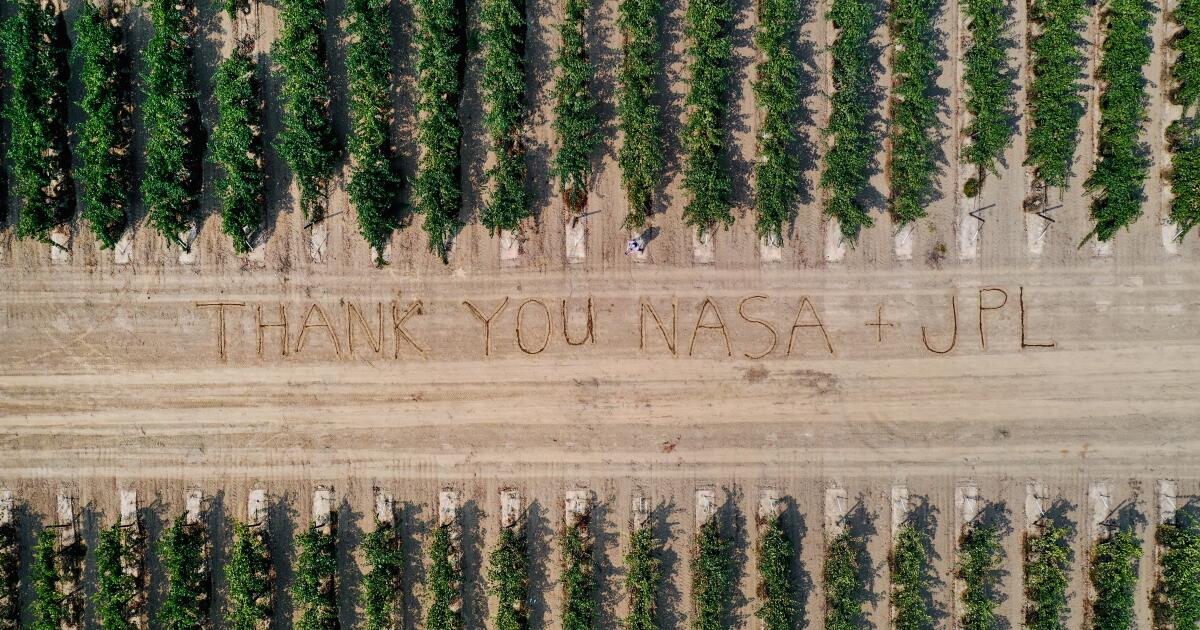Science
NASA technology can spot wine grape disease from the sky. The world’s food supply could benefit

Cutting-edge NASA imaging technology can detect early signs of a plant virus that, if unaddressed, often proves devastating for wineries and grape growers, new research has found.
While the breakthrough is good news for the wine and grape industry, which loses billions of dollars a year to the crop-ruining disease, it could eventually help global agriculture as a whole.
Using intricate infrared images captured by airplane over California’s Central Valley, researchers were able to distinguish Cabernet Sauvignon grape vines that were infected but not showing symptoms — before the point at which growers can spot the disease and respond.
The technology, coupled with machine learning and on-the-ground analysis, successfully identified infected plants with almost 90% accuracy in some cases, according to two new research papers.
“This is the first time we’ve ever shown the ability to do viral disease detection on the airborne scale,” said Katie Gold, an assistant professor of grape pathology at Cornell University and a lead researcher on the project. “The next step is scaling to space.”
As NASA’s Jet Propulsion Laboratory is working on sending its airborne imaging instrument — a spectrometer known as AVIRIS-NG — into space, the research team is hopeful more routine aerial images and data from the launched machine could be used to more widely monitor crops.
“The ultimate vision is to be able to do this from space — and not just for grapes and not just this one disease and not just a few places in California, but to be able to do this for farmers all over the world, for many different crops and many different diseases and pests,” said Ryan Pavlick, a research technologist at JPL who worked on the grape project.
The implications of such a venture — if successful on a global scale — could “benefit the whole food system,” Gold said.
“If we can detect disease before it’s really spiraling out of control at its early stages [and] make a targeted intervention, we can then more strategically use our resources, reduce the amount of chemistry we’re putting into the environment, as well as make overall operations more sustainable, both from an environmental and financial standpoint,” Gold said.
Less disease and crop loss would mean more limited pesticide use and land use for agriculture — better for human and Earth health — as well as financial benefits, she said.
But that’s still a far-off vision, Pavlick said, with much more research necessary before the spectrometer is set to head up to space at the end of this decade. This latest study, focused on vineyards and the grapevine leafroll virus 3, or GLRaV-3, is a promising example of how this powerful technology can be leveraged, he said.
The leafroll virus is primarily spread across vineyards by the endemic mealybug, and once the disease takes hold the only treatment is removal — costing the U.S. wine and grape industry some $3 billion in damage and losses annually, researchers said.
Right now, the virus is detected by growers only through laborious vine-by-vine analysis and expensive molecular testing, which usually provides results too late, once the virus has already ruined crops and spread.
“This issue is so financially devastating,” said Stephanie Bolton, the research and education director at the Lodi Winegrape Commission, a winegrower advocacy group that assisted in the research. “Once it’s noticeable, it can be pretty widespread throughout a vineyard,” downgrading grapes’ quality and leaving vines completely unusable.
That’s because the leafroll virus has a latent period of one year, Gold said.
“By the time a grapevine is showing symptoms, it’s already been infected for a year and it’s been spreading the virus to all of its neighbors,” Gold said.
So finding a way to identify early infection was key, she said, a challenge that led to the 2020 “wine tour” over Lodi vineyards, a collaboration between JPL and Cornell University.
Researchers flew the AVIRIS-NG, or the next-generation Airborne Visible/InfraRed Imaging Spectrometer developed at JPL, over about 11,000 acres of vineyards near Lodi. The spectrometer captures data from hundreds of channels of light, including those far beyond the visible spectrum — “down into the ultraviolet and well above the infrared,” Pavlick said.
As the machine flies over an area, it creates a map of squiggly lines, full of information on how the light was reflected that can be useful for applications such as detecting methane leaks, measuring the size of a snowflake or understanding the biochemistry of a vegetative canopy.
“From the shape of each of those squiggly lines, we can infer all kinds of things about the earth,” Pavlick said.
Using that data, the research team developed and trained computer models to distinguish the infection, while vineyard collaborators analyzed grapevines for symptoms and provided samples — scouting over 300 acres of vines for two years.
“This work would not have been possible without their commitment,” Gold said.
Bolton, of the Lodi Winegrape Commission, said it was work that local growers in Lodi were excited to be a part of.
“The growers here are really committed to learning and solving their problems and teamwork,” Bolton said of the community of about 750 growers, many of them farming families. “We were pretty excited with the potential.”
The research’s findings focused only on red grapes, but Gold is hopeful the asymptomatic detection could help spot the virus in white grape varieties, which are also affected by the disease but can be harder to spot symptoms of the leafroll virus on.
“We’re really at a renaissance in the use of remote sensing in plant pathology,” Gold said. “We’re finally at this point where we can do what we dreamed of, which is stopping disease before it spirals into an epidemic, to help growers make more sustainable choices.”
Though the study was successful, Gold said it’s not logistically or financially feasible to expand the project with further airplane flights over the thousands of vineyards in California — and all over the world — which is why their eyes are on space.
“Space offers the opportunity to monitor at the scale at which production occurs,” Gold said. “It’s not something just localized to one grower, because vineyards border each other … so we need to manage it at a regional community scale. And space is what offers that opportunity because it just covers a much vaster area.”

Science
Cluster of farmworkers diagnosed with rare animal-borne disease in Ventura County

A cluster of workers at Ventura County berry farms have been diagnosed with a rare disease often transmitted through sick animals’ urine, according to a public health advisory distributed to local doctors by county health officials Tuesday.
The bacterial infection, leptospirosis, has resulted in severe symptoms for some workers, including meningitis, an inflammation of the brain lining and spinal cord. Symptoms for mild cases included headaches and fevers.
The disease, which can be fatal, rarely spreads from human to human, according to the U.S. Centers for Disease Control and Prevention.
Ventura County Public Health has not given an official case count but said it had not identified any cases outside of the agriculture sector. The county’s agriculture commissioner was aware of 18 cases, the Ventura County Star reported.
The health department said it was first contacted by a local physician in October, who reported an unusual trend in symptoms among hospital patients.
After launching an investigation, the department identified leptospirosis as a probable cause of the illness and found most patients worked on caneberry farms that utilize hoop houses — greenhouse structures to shelter the crops.
As the investigation to identify any additional cases and the exact sources of exposure continues, Ventura County Public Health has asked healthcare providers to consider a leptospirosis diagnosis for sick agricultural workers, particularly berry harvesters.
Rodents are a common source and transmitter of disease, though other mammals — including livestock, cats and dogs — can transmit it as well.
The disease is spread through bodily fluids, such as urine, and is often contracted through cuts and abrasions that contact contaminated water and soil, where the bacteria can survive for months.
Humans can also contract the illness through contaminated food; however, the county health agency has found no known health risks to the general public, including through the contact or consumption of caneberries such as raspberries and blackberries.
Symptom onset typically occurs between two and 30 days after exposure, and symptoms can last for months if untreated, according to the CDC.
The illness often begins with mild symptoms, with fevers, chills, vomiting and headaches. Some cases can then enter a second, more severe phase that can result in kidney or liver failure.
Ventura County Public Health recommends agriculture and berry harvesters regularly rinse any cuts with soap and water and cover them with bandages. They also recommend wearing waterproof clothing and protection while working outdoors, including gloves and long-sleeve shirts and pants.
While there is no evidence of spread to the larger community, according to the department, residents should wash hands frequently and work to control rodents around their property if possible.
Pet owners can consult a veterinarian about leptospirosis vaccinations and should keep pets away from ponds, lakes and other natural bodies of water.
Science
Political stress: Can you stay engaged without sacrificing your mental health?

It’s been two weeks since Donald Trump won the presidential election, but Stacey Lamirand’s brain hasn’t stopped churning.
“I still think about the election all the time,” said the 60-year-old Bay Area resident, who wanted a Kamala Harris victory so badly that she flew to Pennsylvania and knocked on voters’ doors in the final days of the campaign. “I honestly don’t know what to do about that.”
Neither do the psychologists and political scientists who have been tracking the country’s slide toward toxic levels of partisanship.
Fully 69% of U.S. adults found the presidential election a significant source of stress in their lives, the American Psychological Assn. said in its latest Stress in America report.
The distress was present across the political spectrum, with 80% of Republicans, 79% of Democrats and 73% of independents surveyed saying they were stressed about the country’s future.
That’s unhealthy for the body politic — and for voters themselves. Stress can cause muscle tension, headaches, sleep problems and loss of appetite. Chronic stress can inflict more serious damage to the immune system and make people more vulnerable to heart attacks, strokes, diabetes, infertility, clinical anxiety, depression and other ailments.
In most circumstances, the sound medical advice is to disengage from the source of stress, therapists said. But when stress is coming from politics, that prescription pits the health of the individual against the health of the nation.
“I’m worried about people totally withdrawing from politics because it’s unpleasant,” said Aaron Weinschenk, a political scientist at the University of Wisconsin–Green Bay who studies political behavior and elections. “We don’t want them to do that. But we also don’t want them to feel sick.”
Modern life is full of stressors of all kinds: paying bills, pleasing difficult bosses, getting along with frenemies, caring for children or aging parents (or both).
The stress that stems from politics isn’t fundamentally different from other kinds of stress. What’s unique about it is the way it encompasses and enhances other sources of stress, said Brett Ford, a social psychologist at the University of Toronto who studies the link between emotions and political engagement.
For instance, she said, elections have the potential to make everyday stressors like money and health concerns more difficult to manage as candidates debate policies that could raise the price of gas or cut off access to certain kinds of medical care.
Layered on top of that is the fact that political disagreements have morphed into moral conflicts that are perceived as pitting good against evil.
“When someone comes into power who is not on the same page as you morally, that can hit very deeply,” Ford said.
Partisanship and polarization have raised the stakes as well. Voters who feel a strong connection to a political party become more invested in its success. That can make a loss at the ballot box feel like a personal defeat, she said.
There’s also the fact that we have limited control over the outcome of an election. A patient with heart disease can improve their prognosis by taking medicine, changing their diet, getting more exercise or quitting smoking. But a person with political stress is largely at the mercy of others.
“Politics is many forms of stress all rolled into one,” Ford said.
Weinschenk observed this firsthand the day after the election.
“I could feel it when I went into my classroom,” said the professor, whose research has found that people with political anxiety aren’t necessarily anxious in general. “I have a student who’s transgender and a couple of students who are gay. Their emotional state was so closed down.”
That’s almost to be expected in a place like Wisconsin, whose swing-state status caused residents to be bombarded with political messages. The more campaign ads a person is exposed to, the greater the risk of being diagnosed with anxiety, depression or another psychological ailment, according to a 2022 study in the journal PLOS One.
Political messages seem designed to keep voters “emotionally on edge,” said Vaile Wright, a licensed psychologist in Villa Park, Ill., and a member of the APA’s Stress in America team.
“It encourages emotion to drive our decision-making behavior, as opposed to logic,” Wright said. “When we’re really emotionally stimulated, it makes it so much more challenging to have civil conversation. For politicians, I think that’s powerful, because emotions can be very easily manipulated.”
Making voters feel anxious is a tried-and-true way to grab their attention, said Christopher Ojeda, a political scientist at UC Merced who studies mental health and politics.
“Feelings of anxiety can be mobilizing, definitely,” he said. “That’s why politicians make fear appeals — they want people to get engaged.”
On the other hand, “feelings of depression are demobilizing and take you out of the political system,” said Ojeda, author of “The Sad Citizen: How Politics is Depressing and Why it Matters.”
“What [these feelings] can tell you is, ‘Things aren’t going the way I want them to. Maybe I need to step back,’” he said.
Genessa Krasnow has been seeing a lot of that since the election.
The Seattle entrepreneur, who also campaigned for Harris, said it grates on her to see people laughing in restaurants “as if nothing had happened.” At a recent book club meeting, her fellow group members were willing to let her vent about politics for five minutes, but they weren’t interested in discussing ways they could counteract the incoming president.
“They’re in a state of disengagement,” said Krasnow, who is 56. She, meanwhile, is looking for new ways to reach young voters.
“I am exhausted. I am so sad,” she said. “But I don’t believe that disengaging is the answer.”
That’s the fundamental trade-off, Ojeda said, and there’s no one-size-fits-all solution.
“Everyone has to make a decision about how much engagement they can tolerate without undermining their psychological well-being,” he said.
Lamirand took steps to protect her mental health by cutting social media ties with people whose values aren’t aligned with hers. But she will remain politically active and expects to volunteer for phone-banking duty soon.
“Doing something is the only thing that allows me to feel better,” Lamirand said. “It allows me to feel some level of control.”
Ideally, Ford said, people would not have to choose between being politically active and preserving their mental health. She is investigating ways to help people feel hopeful, inspired and compassionate about political challenges, since these emotions can motivate action without triggering stress and anxiety.
“We want to counteract this pattern where the more involved you are, the worse you are,” Ford said.
The benefits would be felt across the political spectrum. In the APA survey, similar shares of Democrats, Republicans and independents agreed with statements like, “It causes me stress that politicians aren’t talking about the things that are most important to me,” and, “The political climate has caused strain between my family members and me.”
“Both sides are very invested in this country, and that is a good thing,” Wright said. “Antipathy and hopelessness really doesn’t serve us in the long run.”
Science
Video: SpaceX Unable to Recover Booster Stage During Sixth Test Flight

President-elect Donald Trump joined Elon Musk in Texas and watched the launch from a nearby location on Tuesday. While the Starship’s giant booster stage was unable to repeat a “chopsticks” landing, the vehicle’s upper stage successfully splashed down in the Indian Ocean.
-

 Business1 week ago
Business1 week agoColumn: Molly White's message for journalists going freelance — be ready for the pitfalls
-

 Science6 days ago
Science6 days agoTrump nominates Dr. Oz to head Medicare and Medicaid and help take on 'illness industrial complex'
-

 Politics1 week ago
Politics1 week agoTrump taps FCC member Brendan Carr to lead agency: 'Warrior for Free Speech'
-
/cdn.vox-cdn.com/uploads/chorus_asset/file/25739950/247386_Elon_Musk_Open_AI_CVirginia.jpg)
/cdn.vox-cdn.com/uploads/chorus_asset/file/25739950/247386_Elon_Musk_Open_AI_CVirginia.jpg) Technology1 week ago
Technology1 week agoInside Elon Musk’s messy breakup with OpenAI
-

 Lifestyle1 week ago
Lifestyle1 week agoSome in the U.S. farm industry are alarmed by Trump's embrace of RFK Jr. and tariffs
-

 World1 week ago
World1 week agoProtesters in Slovakia rally against Robert Fico’s populist government
-

 Health2 days ago
Health2 days agoHoliday gatherings can lead to stress eating: Try these 5 tips to control it
-

 News1 week ago
News1 week agoThey disagree about a lot, but these singers figure out how to stay in harmony

/cdn.vox-cdn.com/uploads/chorus_asset/file/25286459/247024_Pilot_Pen_CVirginia.jpg)












